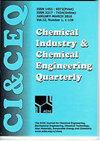新型陶瓷复合材料的抗冻作用和微生物腐蚀性能
IF 0.8
4区 工程技术
Q4 CHEMISTRY, APPLIED
Chemical Industry & Chemical Engineering Quarterly
Pub Date : 2022-01-01
DOI:10.2298/ciceq210904016j
引用次数: 0
摘要
这项工作说明了对陶瓷压坯的霜冻作用机制的预测,以及它们对真菌作用的生物耐腐蚀性。陶瓷压坯由两种原料制成:粉煤灰(40 wt. %)和粘土材料(60 wt. %)。在实验室条件下,通过加压(P = 45 MPa)、干燥(105?C, 3h)和烧结(1100?C, 1 h;加热速率3?C/min和10?C/min)。根据总孔隙率、孔径分布、孔隙临界半径、Maage因子以及透水性值,确定了陶瓷压实材料的劣化机理。以黑曲霉为模型微生物,对生物腐蚀过程进行了研究。根据扫描电镜观察结果,对比分析了不同菌落在设计菌落上的程度。获得的结果令人鼓舞,因为它们表明,与仅基于粘土材料生产的陶瓷复合材料相比,在陶瓷复合材料中使用粉煤灰(40 wt. %)而不会显著降低其耐久性(霜冻作用和微生物耐腐蚀性)。本文章由计算机程序翻译,如有差异,请以英文原文为准。
Resistance to frost action and microbiological corrosion of novel ceramic composites
This work illustrates the prediction of frost action mechanisms on ceramic compacts, as well as their biocorrosion resistance to fungus action. The ceramic compacts were produced from two raw materials: coal fly ash (40 wt. %) and clay material (60 wt. %). The ceramics models were made in laboratory conditions by pressing (P = 45 MPa), drying (105?C, 3h) and sintering (1100?C, 1h; heating rates 3?C/min and 10?C/min.). The mechanisms responsible for the deterioration of the designed ceramic compacts were defined based on the values of the total porosity, pore size distribution, pore critical radius and the Maage factor, as well as on the values of water permeability. The process of biocorrosion was investigated by using Aspergillus niger fungus as a model microorganism. The different degrees of fungus colonization on the designed compacts were comparatively analysed based on the results of the Scanning Electron Microscopy investigation. The gained results are encouraging as they show that the utilization of fly ash (40 wt. %) in ceramic composites is possible without significantly deterioration of their durability (frost action and microbiological corrosion resistance) compared with the ones whose production was based only on clay material.
求助全文
通过发布文献求助,成功后即可免费获取论文全文。
去求助
来源期刊

Chemical Industry & Chemical Engineering Quarterly
CHEMISTRY, APPLIED-ENGINEERING, CHEMICAL
CiteScore
2.10
自引率
0.00%
发文量
24
审稿时长
3.3 months
期刊介绍:
The Journal invites contributions to the following two main areas:
• Applied Chemistry dealing with the application of basic chemical sciences to industry
• Chemical Engineering dealing with the chemical and biochemical conversion of raw materials into different products as well as the design and operation of plants and equipment.
The Journal welcomes contributions focused on:
Chemical and Biochemical Engineering [...]
Process Systems Engineering[...]
Environmental Chemical and Process Engineering[...]
Materials Synthesis and Processing[...]
Food and Bioproducts Processing[...]
Process Technology[...]
 求助内容:
求助内容: 应助结果提醒方式:
应助结果提醒方式:


